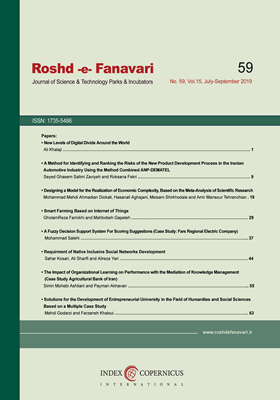-
-
List of Articles
-
Open Access Article
1 - The Impact of Organizational Learning on Performance with the Mediation of Knowledge Management (Case Study Agricultural Bank of Iran)
simin mohebbi ashtiani Peyman Akhavan -
Open Access Article
2 - Solutions for the Development of Entrepreneurial University in the Field of Humanities and Social Sciences Based on a Multiple Case Study
mehdi goodarzi farzaneh khalouei -
Open Access Article
3 - Requirment of Native Inclusive Social Networks Development
Sahar Kousari ali sharifi Alireza Yari -
Open Access Article
4 - A Method for Identifying and Ranking the Risks of the New Product Development Process in the Iranian Automotive Industry Using the Method Combined ANP-DEMATEL
seyed ghasem salimi zavieh roksana fekri -
Open Access Article
5 - A Fuzzy Decision Support System For Scoring Suggestions (Case Study: Fars Regional Electric Company)
Mohammad salehi -
Open Access Article
6 - New Levels of Digital Divide Around the World
ali khalaji -
Open Access Article
7 - Designing a Model for the Realization of Economic Complexity, Based on the Meta-Analysis of Scientific Research
Mohammad Mahdi Ahmadian Divkoti Hassanali Aghajani meysam shirkhodaei Amir Mansour Tehranchian -
Open Access Article
8 - Smart Farming Based on Internet of Things
GholamReza Farrokhi Mahboobeh Gapeleh
-
The rights to this website are owned by the Raimag Press Management System.
Copyright © 2017-2025







